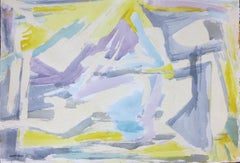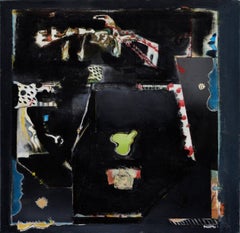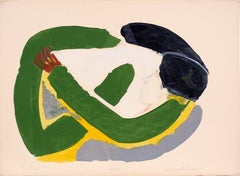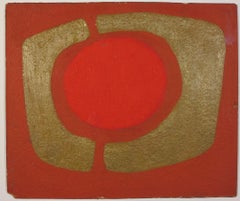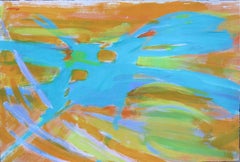Murray Hantman Art
Shaped by his life experiences and a commitment to the practice of making art, the work of Murray Hantman represented a career of personal exploration and aesthetic refinement that took him from New York to Los Angeles, back to New York and eventually to the serene, yet dramatic, the coast of Maine, where he worked as part of the artists’ colony on Monhegan Island. Born in Pennsylvania in 1904, Hantman’s family moved many times to follow his father’s business opportunities, eventually settling in New York. A childhood of economic instability and dislocation formed Murray Hantman’s early years, making him independent and self-reliant from a very early age. Hantman’s father owned movie theatres and photography studios and, recognizing his son’s artistic ability, employed him to print hand-color photographs as a child. When he was eleven and living in Michigan, a public school teacher arranged for Hantman to receive a scholarship to the Detroit Museum of Art School, where after a year he was awarded another scholarship to study at the Detroit School of Design. He studied in Detroit for a year until his family abruptly moved to Alabama, interrupting his artistic and academic studies until the family moved to New York at the end of the first World War. As a young man, Hantman supported himself by working many different jobs in New York and New Jersey. Steady work with his brother at the Hartford and New Haven Railroad office in New York City finally allowed Hantman to pursue his artistic studies formally. In 1928, he enrolled in the Art Students League and became part of a social circle of artists and activists. While at the Art Students League, he worked with faculty members Boardman Robinson and Thomas Hart Benton on two mural projects. During the years around the Great Depression, Hantman worked in Los Angeles with a group of artists known as the Bloc of Painters. Recruited through an advertisement to attend a course on fresco painting, the Bloc group was headed by Mexican muralist David Alfaro Siqueiros, who had recently been exiled from Mexico for political activism. Through his work with Siqueiros, Hantman became motivated by social and political issues and their creative expression. In 1934, He returned to New York and found the community of artists there equally engaged in social justice issues. While enrolling at the newly-formed Artists’ Union to advocate for the labor rights of creative workers, Hantman met sculptor Jo Levy who would become his wife. Like many artists at the time, he found work through the Federal Art Project as a member of the Easel Painting Division, which strove to create “works of art for the public which have a definite social value to the community”. Along with the work he exhibited as a member of the WPA group, Hantman’s work from this period was in the style of Social Realism he learned from Siqueiros. Hantman and his wife, Jo Levy, believed in creating art for the public good. Their Artists’ Union friends and colleagues from the Federal Art Project formed the nucleus of their social circle and would become the community of artists who worked together during summers on Monhegan Island off the coast of Maine. In 1945, Hantman had his first solo painting show at Marquee Gallery in New York and visited Monhegan Island for the first time. The following summer, he and Levy spent the summer in Maine and would continue to do so for the next thirty years. The landscapes and seascapes of Maine would become a central subject in his work after 1946. The dramatic coastline of Monhegan Island had been an inspiration for other New York artists before Hantman, including George Bellows and Rockwell Kent. As Hantman matured as an artist he began to reject academic narrative in his work, moving towards a more expressionistic and abstract style. During this shift into abstraction, nature remained central to his work and the seascape and Maine light provided continual inspiration. In the late 1940s, Hantman began to reduce the landscape into elemental forms of color and shape. As he pursues this mode of painting, his work moves further into abstraction, juxtaposing large blocks of saturated color to convey the drama of sea and sky. Always a student and teacher, Hantman distilled the ideologies of Abstract Expressionism and synthesized its concepts into his work. Throughout the 1950s, he experimented with Action Painting, color, form and expression. By the late 1950s, Hantman’s mature style had developed into abstract works of pure color masses in simple geometric forms. His mastery of color and form continued into his late work, always reflecting the beauty of the natural world around him. Dedicated to the idea of exploration in his art, Hantman made hundreds of small color and form studies that hint at the large-scale works that would follow in the late 1960s and beyond. Hantman’s work from the ‘70s and ‘80s shows even more intensity of color and distillation of composition. The landscape of the Maine coast remained his muse throughout, the stark lines suggesting the flat plane of sea and horizon line beyond. Hantman and Jo Levy lived in New York and summered on Monhegan Island until 1975, followed by summers in Owls Head and New Harbor, Maine, until 1988, the year of his last solo exhibition, at the Portland Museum of Art. In 1989, Hantman showed with Levy in a group exhibition. Levy died in 1996, followed by Hantman in 1999.
Mid-20th Century Abstract Expressionist Murray Hantman Art
Watercolor
Mid-20th Century Abstract Expressionist Murray Hantman Art
Canvas, Oil
1980s Abstract Expressionist Murray Hantman Art
Canvas, Ink, Mixed Media, Oil
21st Century and Contemporary Abstract Expressionist Murray Hantman Art
Paper, Acrylic, Gouache, Pencil
Late 20th Century Abstract Expressionist Murray Hantman Art
Canvas, Oil
Early 2000s Abstract Expressionist Murray Hantman Art
Canvas, Acrylic, Oil, Cardboard
2010s Abstract Expressionist Murray Hantman Art
Tempera, Watercolor, Paper
2010s Abstract Expressionist Murray Hantman Art
Gold Leaf
21st Century and Contemporary Abstract Expressionist Murray Hantman Art
Paper, Watercolor
1980s Abstract Expressionist Murray Hantman Art
Canvas, Oil
1950s Abstract Expressionist Murray Hantman Art
Watercolor
1960s Abstract Expressionist Murray Hantman Art
Gouache, Archival Paper
2010s Abstract Expressionist Murray Hantman Art
Canvas, Oil
20th Century Abstract Expressionist Murray Hantman Art
Canvas, Oil
Mid-20th Century Abstract Murray Hantman Art
Oil, Illustration Board
1950s Abstract Expressionist Murray Hantman Art
Acrylic
Mid-20th Century Abstract Geometric Murray Hantman Art
Canvas, Oil
1950s Abstract Expressionist Murray Hantman Art
Canvas, Oil
